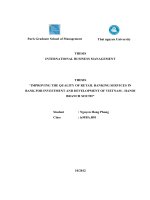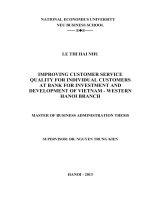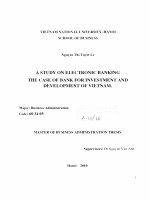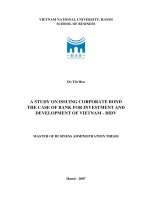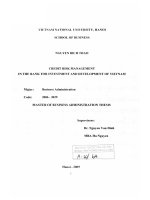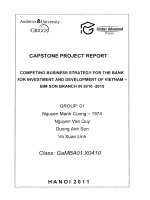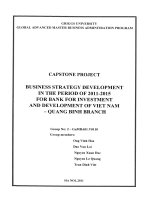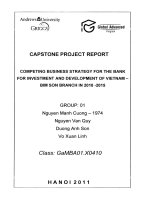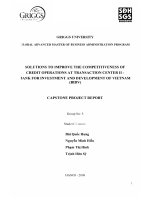Emotional exhaustion in retail operation at bank for investment and development of vietnam – north saigon branch
Bạn đang xem bản rút gọn của tài liệu. Xem và tải ngay bản đầy đủ của tài liệu tại đây (21.96 MB, 71 trang )
UNIVERSITY OF ECONOMICS HO CHI MINH CITY
International School of Business
Do Phat Tai
EMOTIONAL EXHAUSTION
IN RETAIL OPERATION
AT BANK FOR INVESTMENT
AND DEVELOPMENT OF VIETNAM
– NORTH SAIGON BRANCH
ID: 22140042
MASTER OF BUSINESS ADMINISTRATION
SUPERVISOR: DR. PHAM PHU QUOC
Ho Chi Minh City – 2017
Executive summary
In recent years, BIDV North Saigon branch has showed some symptom of poor
performance in retail banking operation in comparison with average of entire BIDV
system as well as with other branches in Ho Chi Minh City region. Through in-depth
analysis and theory informed, “emotional exhaustion” was identified as the main
problem that leads to poor performance of retail operation in the branch. There are 3
causes considered to be reason for the main problem, they are performance appraisal bias
from retail leaders, coworker incivility and work overload. In consideration with the
conditions of the branch and theories support, “coworker incivility” was appointed the
main cause leading to the problem “emotional exhaustion” in retail operation. Four
potential solutions was suggested and evaluated, two of them (Issuing Branch Code of
Conduct and Setting up extracurricular activities) were selected to solve the main
problem “emotional exhaustion” to improve the performance of retail operation in BIDV
North Saigon branch.
1
Table of content
Executive summary ...........................................................................................................1
CHAPTER 1: PROBLEM IDENTIFICATION .............................................................6
1.1. Problem conceptualization: .......................................................................................6
1.1.1. Company overview: ............................................................................................6
1.1.2. Retail banking overview: ....................................................................................8
1.1.3. Symptoms: ..........................................................................................................9
1.2. Problem Identification .............................................................................................14
1.3. Problem definition ...................................................................................................22
1.4. Problem existence ...................................................................................................23
1.5. Importance of the problem-consequences and the validation .................................26
1.6. Causes of problem and the validation .....................................................................28
CHAPTER 2: SOLUTION .............................................................................................33
2.1 Proposal of solution: ................................................................................................33
2.2. Potential Solution Evaluation:.................................................................................36
2.3. Action Plan: .............................................................................................................41
References.........................................................................................................................45
Appendix 1: Symptoms ...................................................................................................50
Appendix 2: Problem Identification: .............................................................................54
Appendix 3: Problem existence: (Question list from research of Maslach and
Jackson, 1981): ................................................................................................................56
Appendix 4: Problem importance and causes validation: ...........................................59
Appendix 5: Interview of solution and organizations of actions. ................................62
Appendix 6: Survey form for proving existence of emotional exhaustion in retail
operation in North Saigon branch and other branches in HCMC region. ................65
Appendix 7: Retail criterias in comparison with entire BIDV system 2013 – 2015 ..66
2
Appendix 8: Growth rate of retail criterias 2013 – 2015 in comparison with other
branches in HCMC region ..............................................................................................67
Appendix 9: Productivity and Proportion of retail operation in comparison with
other branches in Ho Chi Minh city region in 2015 .....................................................68
3
List of Figure
Figure 1 – Retail operation structure of BIDV North Saigon branch ..........................7
Figure 2 – Initial Cause –effect map ..............................................................................19
Figure 3 – Final Cause-effect map .................................................................................32
Figure 4 - Summarized timeline of Action Plan for dealing with Emotional
Exhaustion in retail operation ........................................................................................44
5
List of Table
Table 1 – Retail departments name abbreviation ..........................................................8
Table 2 – Comparison on average growth of retail criteria 2013-2015 between
Entire BIDV system and BIDV North Saigon branch. ................................................10
Table 3 – Comparison on retail proportion of retail criteria between Entire BIDV
system and BIDV North Saigon branch. .......................................................................11
Table 4 – Comparison on Retail Capital Mobilization between BIDV North Saigon
branch and other branches in HCMC region ...............................................................12
Table 5 – Comparison on Retail Loan Outstanding between BIDV North Saigon
branch and other branches in HCMC region ...............................................................12
Table 6 – Comparison on Retail Profit between BIDV North Saigon branch and
other branches in HCMC region ....................................................................................13
Table 7 – Summary of opinions on potential problems in retail operation ...............19
at BIDV North Saigon branch ........................................................................................19
Table 8 – Comparison on number of day-off between retail employees and
employees from other operation in the branch. ............................................................22
Table 9 – Result of emotional exhaustion survey in BIDV North Saigon branch and
some other branch ...........................................................................................................25
Table 10 – Solution suggested and evalution ................................................................40
4
CHAPTER 1: PROBLEM IDENTIFICATION
1.1. Problem conceptualization:
1.1.1. Company overview:
Bank for Investment and Development of Vietnam JSC (BIDV) is the bank with
the oldest history of Vietnam (58 years), who has always accompanied with the
important stages in the economic of the country. In 2015, 20-year milestone - BIDV
transformed from a state capital serving to a commercial bank operating under market
principles. After 20 years of renovation, the Bank has made great progress, becoming
one of the two banks which have the largest banking system in Vietnam.
With the goal of development and expansion of the Bank's network across the country,
especially in key economic areas in the south, BIDV Tan Binh Branch was established
on 01/12/2005, became the 8th BIDV branch presenting in HCM City at the time. Till
01/2008, Tan Binh Branch was officially renamed as Branch Commercial Bank for
Investment and Development of North Saigon.After 10 years, from initial 48 employees
with 6 departments and 1 transaction office, the total number of staff now has reached
over 140 employees, with 16 departmentsincluding 4 transaction officeslocated in Tan
BinhDistrict, Go Vap District and District 10. BIDV North Saigon also completed
expanding network tasks entrusted by BIDV headquarter: the establishment of new Tan
Binh Branch, support human resources for merging Mekong Housing Bank (MHB)
branches in 2015, for BIDV branches inside and outside the region.
In June of 2015, the branch received Tan Son Nhat transaction office (now
renamed to Nhat Tao transaction office) from the bank MHB, which was merged to
6
BIDV in April of 2015. Until December 31st 2015, the retail operation of the branch
comprised: Individual Customers department and 4 transaction offices located at Tan
Binh district, Go Vap district, district 10. With the scale of 69 employees (accounting for
42% total number of employee of entire branch), most of retail employees are young,
enthusiastic, dynamic and equipped full of operational knowledge, suitable with business
environment.
In 2015, retail operation of the branch was structured with 5 departments as the
diagram below:
RETAIL OPERATION
69 employees
ICT Dept
16 employees
IC Dept
14 employees
Leader: 2
Teller: 4
ATM team:
-Surveyor: 1
-Staff: 1
TR team:
-Surveyor: 2
-Staff: 6
Leader: 4
Surveyor: 1
Staff: 9
Cong Hoa TO
12 employees
Leader: 3
RM: 2
Teller: 7
Go Vap TO
14 employees
Leader: 3
RM: 3
Teller: 8
Nhat Tao TO
7 employees
Leader: 2
Surveyor: 1
RM: 1
Teller: 3
Figure 1 – Retail operation structure of BIDV North Saigon branch
Tổ hoàn thuế
-KSV: 2 ng
-CB: 6ng
Abbreviation
Description
ICT Dept
Individual Customer Transaction Department
IC Dept
Individual Customer Department
7
Abbreviation
Description
Cong Hoa TO,
Cong Hoa transaction office, Go Vap transaction
Go Vap TO, Nhat office, Nhat Tao transaction office
Tao TO
TR team
Tax Refund team: The team works inside the
International Terminal – Tan Son Nhat International Airport,
which
Table 1 – Retail departments name abbreviation
1.1.2. Retail banking overview:
Retail banking also known as Consumer Banking is the provision of services by a
bank to individual consumers, rather than to companies, corporations or other banks.
Services offered include savings and transactional accounts, mortgages, personal loans,
debit cards, and credit cards. The term is generally used to distinguish these banking
services from investment banking, commercial banking or wholesale banking. It may
also be used to refer to a division or department of a bank dealing with retail customers.
Currently there is no exact definition of the concept of retail banking. The
definition of retail banking often comes from services or customers that the product
forward. According to the most common interpretation, retail banking is actively
providing financial products and services primarily to customers, who are individuals,
households and small businesses. Retail banking services provision application of
financial products and services to individuals through a network of individual branches,
8
transaction offices, or the customer can have direct access to banking products and
services through the media, electronics and telecommunications.
Vietnam, which has population of about 90 million people with growing income,
is a potential market of commercial banks. This market will grow significantly in the
future due to income growth and the growth of various types of enterprises. Commercial
banks tend to move to the retail, improving access to individual clients, small and
medium-sized enterprises. When switched to retail, banks will have larger markets,
potential growth and of course, there may be increasing risk diversification in business.
1.1.3. Symptoms:
Nowadays, retail banking has been identified as the major operation of
commercial banks to its development strategy. Following this trend of banking sector,
BIDV has issued rational strategy to develop retail banking operation with proper
methods and synchronistically organizing from head quarter to branches.Due to this
strategy, result of retail banking operation in the period 2013 – 2015 was at high-level
growth in scale, efficiency and quality. In 2015, according to Internal report of BIDV
2013 - 2015, BIDV continues maintaining the 1th position in retail banking operation in
Vietnam with the retail banking scale of 495 thousand billion VND. In some other main
retail banking criterions, BIDV has also made remarkable results:
- Retail Capital Mobilization in 2015 was 355 thousand billion VND, increasing
1.7 times in comparison with 2013, which made BIDV lead at the 1th position about
retail capital mobilization among comercial banks in Vietnam.
9
- Retail Loan outstanding in 2015 was 140 thousand billion VND, increasing 2.4
times in comparison with 2013, which made BIDV have the most loan outstanding
among comercial banks in Vietnam.
- Retail Profit in 2015 was 8.6 thousand billion VND, increasing nearly 2 times
after 2 years, average growth in 2013-2015 period was 33%.
In the trend of retail operation development, in contrast, the retail operation of
BIDV North Saigon branch has showed inefficiency in comparison with entire BIDV
system and other BIDV branches in Ho Chi Minh City region.
Inefficient in comparison with entire BIDV system
In the period 2013-2015, the average growth rate of BIDV North Saigon in all
main retail criteria (Retail Loan Outstanding, Retail Profit, Number of Retail customers)
were much lower than entire BIDV system. Specific figures are shown in the table
below:
Criteria
Retail Capital Mobilization (RCM)
Retail Loan Outstanding (RLO)
Retail Profit (RP)
Number of Retail customers
Average growth rate 2013 - 2015
BIDV North
Entire BIDV system
Saigon
30%
14%
55%
26%
33%
18%
18%
8%
Difference
-16%
-29%
-15%
-10%
Table 2 – Comparison on average growth of retail criteria 2013-2015 between
Entire BIDV system and BIDV North Saigon branch.
Besides, about the proportion criterias, BIDV North Saigon branch is also at a low
level in comparison with entire BIDV system:
10
Criteria
RCM/Total CM proportion
RLO/Total LO proportion
RP/Total profit proportion
Proportion in 2015
Difference
BIDV North
Entire BIDV system
Saigon
54%
27%
-27%
23%
8%
-15%
60%
25%
-35%
Table 3 – Comparison on retail proportion of retail criteria between Entire BIDV
system and BIDV North Saigon branch.
From those figures above, it can be seen that retail operation of BIDV North
Saigon branch is deviating with the development tendency of entire BIDV system which
prioritizes to promote and develop retail banking operation.
Inefficient in comparison with other branches in Ho Chi Minh City region
The performance of retail operation in the branch is also not satisfactory in
comparison with other BIDV branches in Ho Chi Minh City region on many criteria:
Capital Mobilization
At the end of 2015, retail capital mobilization of BIDV North Saigon was 2,628
billion VND, ranking 7th among 15 BIDV branches (excepting MHB merged in 2015) in
Ho Chi Minh City region. Besides, capital mobilization (CM) per retail employee in
2015 was 46.11 billion VND, ranking 13th among 15 BIDV branches in Ho Chi Minh
City region, whereas the average CM per retail employee in the region was 62.62 billion
VND.
Moreover, the retail CM/total CM proportion was just 27%, ranking the last
position among 15 branches in the region. Whereas the average of this proportion in the
region was 53%, which means that retail CM accounts more than a half of total CM in
11
the region. With those figure and comparison, it can be seen that retail CM operation in
BIDV North Saigon branch is quite ineffective.
Ranking among 15
CAPITAL
branches in HCM city
Average
Value
MOBILIZATION (CM)
region (excepting MHB
in the region
branches merged in 2015)
RCM per employee
46.11
13
62.62
RCM growth rate 2013-2015
14%
13
24%
RCM/Total CM proportion
27%
15
53%
Table 4 – Comparison on Retail Capital Mobilization between BIDV North Saigon
branch and other branches in HCMC region
Loan outstanding
Ranking among 15
LOAN OUTSTANDING
branches in HCM city
Average
region (excepting MHB
in the region
Value
(LO)
branches merged in 2015)
RLO per retail employee
12.7
11
15.37
LO growth rate 2013-2015
26%
14
53%
RLO/Total LO proportion
8%
14
13%
Table 5 – Comparison on Retail Loan Outstanding between BIDV North Saigon
branch and other branches in HCMC region
12
In 2015, Loan outstanding (LO) per retail employee of the branch was 12.7 billion
VND, ranking for the 11th of 15 branches in the region, less than 2.67 billion VND in
comparison with the average LO per retail employee in the region. Besides, the ratio
Retial LO/Total LO proportion was very low (8%), ranking as the 14th of 15 branches in
the region. In addition, RLO growth rate in 2013-2015 of the branch was also in the
bottom group in the region.
Retail profit
Ranking among 15
RETAIL PROFIT (RP)
branches in HCM city
Average
region (excepting MHB
in the region
Value
branches merged in 2015)
RP per retail employee
1.09
9
1.29
RP growth rate 2013-2015
18%
14
36%
RP/Total RP proportion
21%
15
36%
Table 6 – Comparison on Retail Profit between BIDV North Saigon branch and
other branches in HCMC region
In 2015, Retail Profit (RP) per retail employee of the branch was 1.09 billion
VND, ranking 9th of 15 branches in Ho Chi Minh City region (excepting MHB branches
merged in 2015). About Retail RP/Total RP proportion, BIDV North Saigon branch was
ranked at the last position with 21%, much lower than the average (36%) in the region.
13
Besides, in recent years there are also many signs that show problem with
productivity of working of retail operation such as: received many complaint from
customers about attitude of working, high turnover rate of retail operation, many day-off
of retail employees, bad relationship among employees…
Based on some analysis above, we can see that retail operation in North Saigon
branch is ineffective in comparison to other branches in Ho Chi Minh City region. This
can be resulted from some problems that should be analyzed seriously and generate
solutions to make improve Retail operation in the branch.
1.2. Problem Identification
The method to find out the problem that makes retail operation inefficient in
operating is interviewing BIDV North Saigon branch’s staff. The initial interviews were
conducted with five people of the branch who are relevant with retail operation, they are
Mrs. Hien – Deputy Director of Retail operation who is responsible for setting up the
general development strategy for retail operation of the branch, Mr. Hai-Head
department of Individual customers who is in charge of deploying, improving retail
products at the branch and setting up action program to promote the development of
retail operation, Mrs. Ngan - Head of Nhat Tao transaction office who is in charge of
developing retail operation of the branch at the region of District 10, Mr. Hung – former
retail employee of Individual Customers department and Mrs. Thuy - Head department of
Human Resource who is responsible for recruiting employees for all departments of the
branch including departments of retail operation and responsible for other problems
14
relevant with human resource in the branch. The interview questions and transcripts are
shown in Appendix 1.
According to the result of interviews, each interviewee showed their own opinion
on the problem that made the retail operation in the branch inefficient in comparison with
other branches in the region. In summary, problems that interviewees supposed to be the
potential problems leading to inefficiency of retail operation were: Emotional
exhaustion, Bad business process and Inappropriate recruitment policy.
Emotional exhaustion
Through the interview, Mrs. Hien supposed that the inefficiency of retail operation
in the branch was resulted from situation of emotional exhaustion of retail employees.
Cordes & Dougherty1 also indicated that staffs who suffer from intensively
emotional exhaustion are not able to fulfill their tasks and have poor performance
in delivery service. To describe more detail about the situation of emotional
exhaustion of retail employees, Mrs. Hien indicated that she often saw retail employees
come to workplace with tired faces. She also saw tellers, who often communicated with
customers, not smile and often show attitude of tardinesswhen making transactions with
customers. Mrs. Hien also implied that she had warned retail employees about this
situation but the situation still continued and was not improved. Bozionelos et al2 also
revealed the presence of a substantial number of interaction effects in the relationship of
emotion work with emotional exhaustion and work attitudes. Therefore, with the effect
of emotional exhaustion on attitude of working, the branch has received many complaint
from customers about retail employees, especially retail tellers. Mrs. Hien also told that
15
the relationship among employees as well as relationship between employees and leaders
was not good, which could make employees feel uncomfortable when working in the
branch. Therefore, Mrs. Hien assumed that the situation of low working spirit of retail
employees can be resulted from working condition and environment of the branch, in
detail, she implied that retail employees are almost emotionally exhausted from work.
With the similar opinion with Mrs. Hien, Mrs. Thuy - Head department of Human
Resource also assumed that retail employees are in the situation of emotional exhaustion.
Mrs. Thuy informed that she often saw retail employees come to workplace with bad
mood and easily got angry with colleagues when there were conflicts. The employees
were looked very exhausted and sometimes she detected that retail employees often slept
on desk in working time. Moreover, as statistical figure, the average number of absent
days of retail employees was more than the average of other operation (wholesale
operation, internal management operation…). Therefore, Mrs. Thuy assumed that there
was problem with emotion of retail employees when working, which leads to many
negative symptoms and makes performance of retail operation inefficient in comparison
with other BIDV branches.
Another interview with Mr. Hung – former employees of Individual Customers
department has been performed to get the experience and opinion of an ex-employee.
According to Mr. Hung, there were many reason that made him decide to quit the job,
such
as:
high
pressure
from
work,
unchanged
benefit
and
unsatisfactory
recognition…However, Mr. Hung supposed that working environment is the main reason
that made him decide to leave. In detail, Mr. Hung informed that he could not get on well
16
with his coworker. He supposed that their coworker were very selfish, they seem to care
their own work and there was no help or support among employees. He also revealed that
his leader did not give any support or encouraging words to him, Mr. Hung was often
shouted by this leader for many times although he tried to work very hard to achieve the
target. With all of those reasons, he assumed that he had to handle emotional stress,
which made him unsatisfied about his job and decide to leave the branch.
Bad business process
For Mrs. Ngan - Head of Nhat Tao transaction office, she indicated that retail
employees are affected negatively by current work process of BIDV. Peronja I.3 also
found the relationship between business process change and performance.To be more
detail, Mrs. Ngan assumed that the work process of BIDV is not logical and makes the
employees confused. For instance, Mrs. Ngan implied that retail credit employees have
to complete the credit documents as well as bring credit documents to be notarized at
authority offices; therefore, they almost do not have time for finding out new customers
to develop new customer basis. In addition, when there are too many credit documents
pending, customers often complain and put more pressure on retail credit employees,
which makes them suffer stress from work. Whereas in other banks, there is specific
department which is responsible for completing and bringing credit documents to be
notarized at authority offices, with this mechanism, the employees can have more time to
find out new customers and reduce the stress from work. Besides, Mrs. Ngan also
indicated that information technology system of BIDV is still outdated, which makes it
longer when making transactions with customers and increases handwork actions for
17
employees. As a result, retail employees in the branch are working with the condition of
excess their stamina.
Inappropriate recruitment policy
According to Mr. Hai - Head department of Individual customers, there are some
weakness in recruitment policy of the branch. Rafii et al.4 also found a relationship
between the recruitment with employee performance. Patimah5 has also stated that a
good recruitment program can provide a positive influence towards increasing employee
commitment, productivity, the work quality and performance. In detail, Mr. Hai
indicated that there are some retail employees recruited mainly due to private
relationship with some leaders of the branch although these employees are not qualified
for the job. In some case, Mr. Hai often receives complaint from customers about
employees in his department, they often show improper attitude when communicating
with customers and seem to be lack of knowledge when consulting banking products to
customers, as a result, in some case these employees cannot be guaranteed to accomplish
the missions set by the leaders. Moreover, although the employees are just punished by
reducing the level of salary when they cannot do the job well, the employees are still
retained to work for the department, which makes the inefficiency of retail departments
become more serious gradually. Therefore, Mr. Hai assumed that recruitment policy
affects directly to the performance of retail operation.
Through the interviews with many employees from different departments who are
relevant to retail operation of the branch, the potential problems that led to the
inefficiency of retail operation can be summarized in the table below:
18
Interviewees
Potential problems
Mrs. Hien
Mrs. Thuy
Emotional exhaustion of retail employees
Mr. Hung
Mrs. Ngan
Bad business process
Mr. Hai
Inappropriate recruitment policy
Table 7 – Summary of opinions on potential problems in retail operation
at BIDV North Saigon branch
To generalize the cause-effect relationship between negative symptom happening
in retail operation and potential problems detected, initial cause-effect map was set up:
Figure 2 – Initial Cause –effect map
19
Interviewing with Mr. Thuy - Head of Human Resource department have been
performed to define the problem in retail operation of BIDV North Saigon branch and
whether it could be easily proposed to change in conjunction with branch’s current
resources and general target.
For the potential problem Bad work process, Mrs. Thuy indicated that this problem
also exist in other operation (wholesale operation, internal management operation) and
even in retail operation in other branches in BIDV system. This problem can be classified
as a systematic problem because all BIDV branches apply the same working process
issued by BIDV Headquarter and it takes very long time to change the business process.
Therefore, Bad work process cannot be considered as main problem leading to the
inefficiency of retail operation.
Discussing about inappropriate recruitment policy of retail operation in the
branch, Mrs. Thuy supposed that inappropriate recruitment policy cannot be considered
as the main problem that lead to the inefficiency of retail operation of the branch. Mrs.
Thuy indicated that there are more than 80%of retail employees graduated from top
famous economic university in Vietnam. Besides, graduation mark of retail employees is
almost high, more than 90% of retail employees get the graduation markhigher than 7.5
on the scale of 10. Moreover, retail employees are compulsory to attend training course
to upgrade knowledge and information relevant to daily working, some training course
can be listed such as: communication skill training, services products information
training. After every training courses, the employees will be tested to assure that they can
20
master all the knowledge supplied from the training courses. Besides, all the employees
will be compulsory to do the “Ability test” periodically once in 2 years, the employees
must pass this test to sign the new labor contract with the branch. In addition, if
employees do not do the job well, with the suggestion from leaders they will be moved to
other department or even forced to be fired. Therefore, Mrs. Thuy assumed that the
inefficiency of retail operation is not resulted from recruitment policy of the branch,
because retail employees in the branch almost get good educational background from the
beginning and often equipped enough knowledge and skills to meet the requirement of
works.
As a result, both Bad business process and Inappropriate recruitment policy
should not be considered the main problem that leads to inefficiency of retail operation.
According to Mrs. Thuy, the main problem that leads to low working spirit is
resulted from negative emotion of retail employees in workplace. To prove that, Mrs.
Thuy showed the noticeable figure: the number of day-off of retail employees in 2016
was 7.6 days a year, whereas the average number of day-off of all employees in the
branch was just 5.6 days a year. Schaufeli et al6 also found the relationship between
emotional exhaustion and duration of sick leaves.
Operation
Number of employees
Average day-off
Retail operation
63
7.6
Wholesale operation
30
4.2
46
3.9
Internal management
operation
21
Operation
Number of employees
Average day-off
Total of the branch
139
5.6
Table 8 – Comparison on number of day-off between retail employees and
employees from other operation in the branch.
Besides, in recent years number of retail employees leaving the branch increases
remarkably which made turnover rate of retail operation get high at 80% in 2015. There
was also research by Wright et al.7 assuming that emotional exhaustion has been shown
to predict future voluntary turnover.
Mrs. Thuy also assumed that retail employees are considered to meet problem
with relationship with their coworkers. There seems to be intangible barrier among
employees, which makes working atmosphere always in situation of tension. With this
working environment, emotion of retail employees is affected negatively and they cannot
be enthusiastic. As a result, the branch should focus on emotion of retail employees as
the main problem that must be solved. In collation with literature review, the main
problem that retail operation is faced with is called “emotional exhaustion”.
1.3. Problem definition
According to Maslach et al.8, emotional exhaustion is described as being
emotionally overextended due to a worker's perception that their job's demands exceed
available resources to do the job. In addition, Lee et al.9 and Wright et al.10 have also
stated that when individuals are emotionally exhausted they feel emotionally and
physically drained and overextended. Maslach et al.10 assumed that the most
22
frequently discovered negative impact of workplace incivility on employee outcomes
in the literature is emotional exhaustion, defined as feelings of emotional
helplessness and the depletion of an individual’s emotional resources. Wright et al. 7
also stated that increased emotional exhaustion generally produces a negative impact
on employee and organizational outcomes such as work stress and low job
satisfaction. As a result, Bakker et al. 11 supposed that emotionally exhausted
employees feel unwell during work, question the sense of their job, and are likely to
have higher turnover intentions. Generally, emotional can affect negatively to mental
problem of employees and especially to employees’ performance, which can lead to
many serious problems in the branch.
1.4. Problem existence
In order to confirm the existence of the problem, the questionairewere also
conducted with retail employees in BIDV North Saigon branch about their opinion and
attitude towards emotional exhaustion in retail operation of the branch. Emotional
exhaustion was measured using the nine-item emotional exhaustion component of the
Maslach Burnout Inventory developed by Maslach et al.8. The survey was conducted
with the style of Yes/No question: (please refer at Appendix 3):
1. Do you feel emotionally drained from your work?
2. Do you feel used up at the end of the workday?
3. Do you feel fatigued when you get up in the morning and have to face
another day on the job?
4. When working with people all day, do you feel it is really a strain for you?
23
